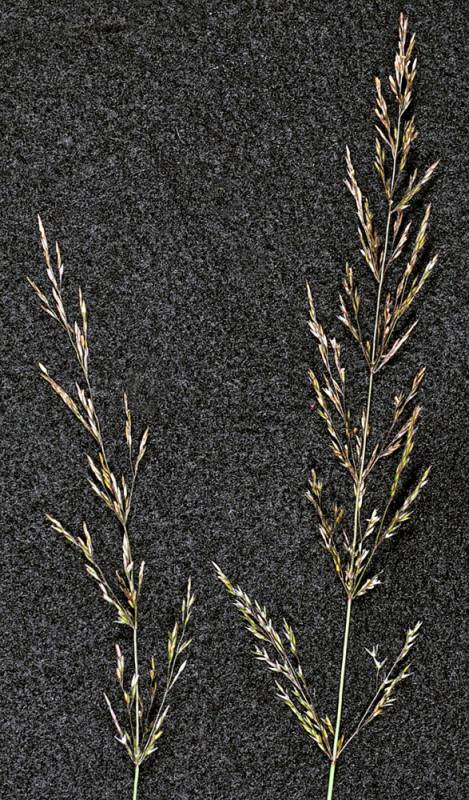Agrostis stolonifera
Agrostis exarata
spreading bent
spiked bent
Sheaths open;
ligules truncate to obtuse, 3-6 mm. long, usually lacerate;
blades flat or folded, 4-10 mm. broad.
Sheaths open, smooth;
ligules 3-8 mm. long, obtuse and lacerate;
blades flat, scabrous, 2-10 mm. broad.
Inflorescence a compressed to somewhat open panicle 5-30 cm. long, usually purplish, bearing spikelets nearly to the base;
spikelets 1-flowered, articulate above the glumes;
glumes subequal, 2-2.5 mm. long, acute;
lemmas 2/3 to 3/4 as long as the glumes, scabrous on the keel, awnless;
palea over 1/2 as long as the lemma;
lodicules 2, 0.4 mm. long.
Inflorescence a congested to open panicle 5-25 cm. long, the branches ascending to erect, green to purplish, scabrous throughout;
spikelets 1-flowered, articulate above the glume;
glumes 2.5-4.5 mm. long, pointed, often with an awn or bristle tip, the second glume somewhat shorter than the first;
lemma 1.5-2.5 mm. long, always shorter than the second glume, sometimes awned from above midlength;
callus slightly bearded;
palea 0.2-0.5 mm. long;
lodicules 2, 0.3-0.5 mm. long
Utricle
Agrostis stolonifera
Agrostis exarata
- Local floras:
BC,
CA,
OR,
WA
- Local Web sites:
CalFlora,
CalPhotos,
Flora NW,
PNW Herbaria
WildflowerSearch
iNaturalist (observations)
USDA Plants Database
- LBJ Wildflower Center
- SEINet
- Plants of the World Online
- Encyclopedia of Life
- Wikipedia
- Google Image Search
- Local floras:
BC,
CA,
OR,
WA
- Local Web sites:
CalFlora,
CalPhotos,
Flora NW,
PNW Herbaria
WildflowerSearch
iNaturalist (observations)
USDA Plants Database
- LBJ Wildflower Center
- SEINet
- Plants of the World Online
- Encyclopedia of Life
- Wikipedia
- Google Image Search



